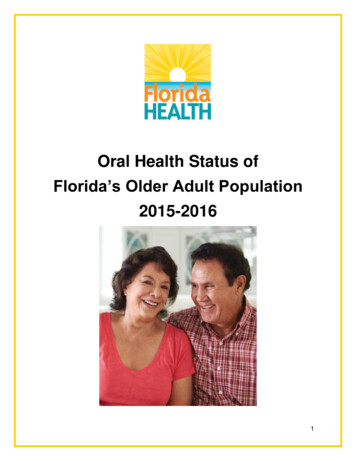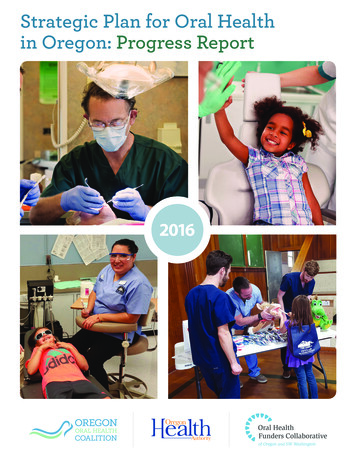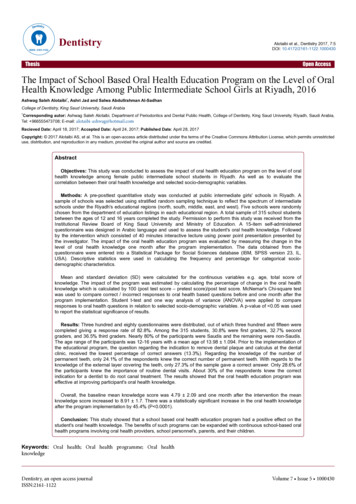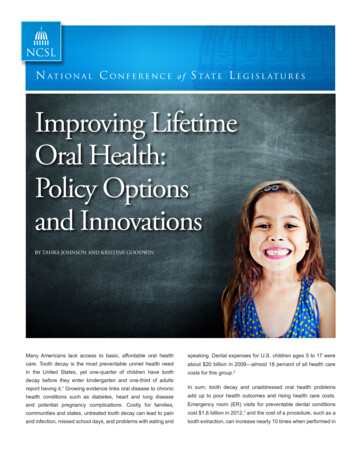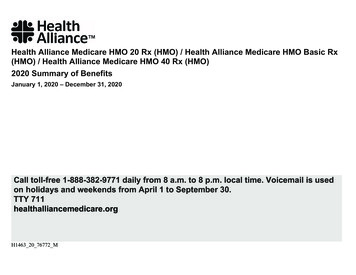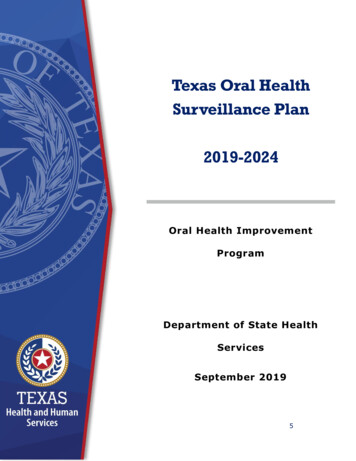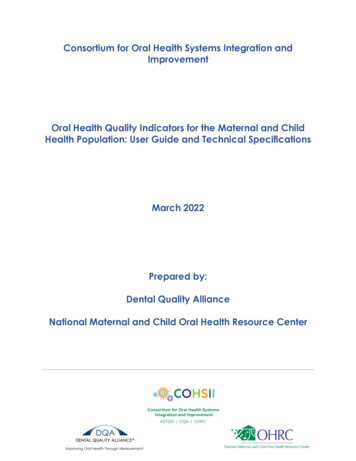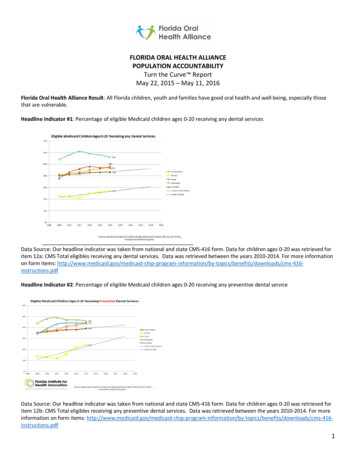
Transcription
FLORIDA ORAL HEALTH ALLIANCEPOPULATION ACCOUNTABILITYTurn the Curve ReportMay 22, 2015 – May 11, 2016Florida Oral Health Alliance Result: All Florida children, youth and families have good oral health and well-being, especially thosethat are vulnerable.Headline Indicator #1: Percentage of eligible Medicaid children ages 0-20 receiving any dental servicesData Source: Our headline indicator was taken from national and state CMS-416 form. Data for children ages 0-20 was retrieved foritem 12a: CMS Total eligibles receiving any dental services. Data was retrieved between the years 2010-2014. For more informationon form items: ctions.pdfHeadline Indicator #2: Percentage of eligible Medicaid children ages 0-20 receiving any preventive dental serviceData Source: Our headline indicator was taken from national and state CMS-416 form. Data for children ages 0-20 was retrieved foritem 12b: CMS Total eligibles receiving any preventive dental services. Data was retrieved between the years 2010-2014. For moreinformation on form items: ctions.pdf1
Secondary Indicator: Number of pediatric preventable ER visits with oral healthData development agenda: Pediatric ER Medicaid dataThe following analysis for pediatric ER visits was completed for 2012 only. Data Source: Florida Pediatric Emergency DepartmentVisits for Preventable Oral Health Conditions: 2012: 14/09/FINAL FIHI Peds ER 9.17.14.pdfData Source: Florida Pediatric Emergency Department Visits for Preventable Oral Health Conditions: ads/2014/09/FINAL FIHI Peds ER 9.17.14.pdfStory behind the baseline:What positive factors have contributed to the baseline? Efforts on behalf of community organizations that focus on oral health School based services that provide oral care FQHC’s that focus on oral health while achieving oral health equity An increase in efforts throughout Florida to improve access to dental care Increase in awareness of the importance of oral health Grassroots efforts directed at improving oral health AHCA added an additional billing code so that health access settings can now bill Medicaid. The state has recognized poor results in Florida. On April 5, 2016, the court ordered the state to improve access andutilization to all health care services for children on Medicaid in Florida. This affects dental care in the following ways: Study on network adequacy will be completed within three to six months. AHCA will amend managed care contracts based on the study results. Managed care companies will need to become more involved in outreach. There will be increased state involvement in coalitions AHCA will continue to implement State Oral Health Action Plan (SOHAP) AHCA will commit to achieve its targets HB5101 that “Extends Florida KidCare coverage to lawfully-residing immigrant children, without a five-year waiting period,beginning on July 1, 2016.” This bill will provide additional enrollment opportunities into the Florida KidCare Program whichincludes health and dental benefits to children ages birth thru 18 years old. This will increase the number of children eligiblefor the Florida KidCare Program on July 1, 2016.What negative factors have contributed to the baseline? An exclusion of certain populations, primarily undocumented population in state. Insufficient data of ER visits for basic care that did not receive preventative services. An increase of local and community initiatives but not many statewide initiatives. A limited reimbursement system that pays for treatments but not for preventative services.2
An ineffective and realistic oral health policy focus in the state.A lack of integration between physical medicine and oral healthHealth education does not include how oral health connects to overall healthAn isolated approach between private providers and public collaborative efforts.A lack of follow up case management systems for patients and members, continuation of care, and post-op.Inadequate number of providers in care network and access points.There is a lack of consistent collaboration and disparity from partners and stakeholders.Low or poor oral health literacy exists. There is a need to increase parental education and overall oral health literacy.Available dental services are not being accessed.There is a need to work consistently and improve the data.Payment to dentists (fees) for preventative services is low which leads to a lack of quality providers.Inadequate funding does not provide access to services which leads to a low number of providers, lack of coverage, andbenefits.Limited pool of money for Medicaid that has to be used effectively and that has led to fraudLack of asset maps that capture known resources and services locationsFragmented knowledge especially about advocacy and outreachCompeting priorities have reduced access to oral health care (example – competing priorities in schools, parents havecompeting priorities (life getting in the way) – have reduced ability for them to get access).Dental office/clinic hours do not meet needs. If closed during evenings and weekends – not seeing a lot of childrenSome dentists will not treat special needs patients because the dentists 1) not trained and 2) no enhanced payment for thisthrough Medicaid. (FQHCs receive an enhanced rate for Medicaid and accept walk-ins and sliding scale fees, but manyfamilies cannot afford sliding scale)Health plans are required by the state to find dental care for consumers “in a timely manner” which includes 30 days nonemergent and 1-2 days for urgent needs.Stakeholders who are involved with oral health consumers do not know how the dental care system works. They need anorientation on how Medicaid system works. Benefits vary from company to company.Some parents are fearful of fluoride which is a part of in-school oral health services.There is a lack of cultural competency among people working at insurance companies, Medicaid agency and dental officeswho are informing people about benefits and making appointments.People answering phones for insurance companies and Medicaid do not know the importance of oral health.Consumers are not aware of what is available to them (interpreters, transportation to appointments, etc.).Confusion exists over mandated requirements for the gross dental exam requirements and forms for health screenings forschool entryPreventive care is not considered in some cultures.Families are stressed and worrying about fulfilling basic needs such as food and housing, priorities that compete with oralhealth care.Story behind the baseline: Prioritized factors Lack of understanding of importance of preventive care and value of oral health (parents and legislators) Lack of information regarding available services and how to access them There are available dental health services that are not being accessed. Inadequate funding does not provide access to services which leads to a low number of providers, lack of coverage, andbenefits. There is a lack of consistent collaboration from partners and stakeholders, including oral health understanding by legislators Services are not meeting the needs of the population, including special needs and children needing special procedures There is a lack of real time data that can identify which patients need dental care. Data is needed at the patient level.3
Partners: Who are the partners that have a role to play to address the prioritized factors?AHCASchool boardsSchool nursesCommunity centersPublic health education campaigns (FDOH)ParentsPediatriciansFQHCsHMO/Insurance companiesProfessional associationsFlorida Association of Insurance PlansFlorida School Based Health AllianceMedical health plansFlorida Hospital AssociationThe Children’s TrustChildren’s services councilsRegional, state or local medical societiesChamber of Commerce - EmployersFaith-based organizationsNonprofitsFlorida Association of Community Health CentersUnited WayFlorida Dental Hygiene AssociationFlorida Area Health Education CentersCatholic councilsNAACPFaith based organizationsNavigatorsMedikidsSpecial Olympics FloridaFlorida Department of EducationHuman services providers/social servicesWICLegislatureSocial servicesChildren’s Services CouncilsDepartment of Children and FamiliesOral health consumers: ParentsNova Southeastern UniversityAcademic institutionsMedical providers (Pediatricians, OB/GYN, nurses)Florida Agency for Health Care Administration(AHCA)Oral health coordinator (several sites)American Academy of PediatriciansFlorida Academy of Pediatric DentistryFlorida Dental AssociationFlorida College of Emergency PhysiciansMedical SocietiesTribal councilsWhat works to turn the curve? Collaboration among stakeholders including legislators Use of best practices used by other states Implementation of dental programs through advocacy and education Grassroots mobilization of community members to develop and promote greater awareness of the importance of good oralhealth Partnerships with FQHC’s providing oral health Literacy and education for women with infants. All successful school based oral health services Martin County 2007 – 2010 school-based screening program Emergency department oral health referral programs Integration of oral health into primary careo Includes having dental hygienist in pediatricians’ offices to provide fluoride varnish and dental care referralsThe group is researching two additional interventions to determine their impact: Required dental exams for school entry Pay for performance reimbursement models Replicable strategies from other fields (tobacco, breast cancer awareness)What worked in Texas: Medicaid provided transportation Dental carve out plan Increased reimbursement rates resulted in more dentists accepting Medicaid “Buy in” of dental association Collaboration between dental association and state department of health4
What do we propose to do?The following strategy ideas serve as a guide for communities. We recommend that communities design and implement additional strategies based on their needs,demographics and environments. Each strategy addresses one of the prioritized factors included in the “story behind the data/baseline”. To assist with designing communityspecific strategies, we have referenced best and promising practices listed in the section entitled “what works”.FocusareaPrioritized factorStrategy ideaOralHealthEducationLack ofunderstanding aboutthe importance ofpreventive care(including legislators)Improve 2-3 year-oldparticipation by increasingengagement and training of nondental workforce in placement offluoride varnish applicationLack of informationregarding availableservices and how toaccess themUtilize online trainings includingbut not limited to the AmericanAcademy of Pediatrics, theUniversity of Florida School ofDentistry, Nova SoutheasternUniversity School of DentalMedicineH H/M HHIncrease oral health knowledge inlow utilization counties bypartnering with communitystakeholders to maximize localresources. Focus on counties with botha higher volume of Medicaideligible children and lowutilization Partner with managed carecompanies to leverage theiroutreach to increase oralhealth education in lowutilization counties Partner with schools in orderto increase oral healtheducation in schools Engage county healthdepartments to serve asBarriersOralHealthEducationLack ofunderstanding aboutthe importance ofpreventive care(including legislators)Leverage, Feasibility, SpecificityValueWhat Works:Evidenced-basedBest practicePartnersSmiles Across es.pdfNova SoutheasternUniversity School ofDental MedicineHealth DepartmentsManaged carecompaniesSchool districts5
OralhealtheducationLack ofunderstanding aboutthe importance ofpreventive care(including legislators)OralhealtheducationLack ofunderstanding ofimportance ofpreventive care andvalue of oral health(parents andlegislators)trainersP: HA:H H/M H/H MCreate and consistently implementthe message in the community forparents and guardians regarding theimportance of oral health preventionand how it relates to educationalattainment. Explore best practices forsuccessful oral health campaigns(Ex: Children’s Dental HealthProject) Identify what exists in Florida andnationally (Ex: MORE Health inTampa provides oral healtheducation in the schools,HHHHEncourage and incentive the provisionof inter-professional educationregarding oral health.HHHHThis includes four types of education:1. Patients/consumereducation: 1) informationabout the importance of oralhealth 2) informationregarding dental benefits andhow to access services2. Education for legislators toincrease their awareness ofthe importance of oralhealth, to encourage them toinclude oral health in policyand appropriations and toChildren’s Dental HealthProjectFlorida DentalAssociationWorkforce DevelopmentFlorida Chamber ofCommerceFlorida Department ofEducationCell phone carriersSchool based HealthAlliancesMORE HealthFlorida Association ofCommunity HealthCenters (FACHC)Make Healthy HappenMiami-Dade campaignTampa Bay Health CareCollaborativeCatalyst MiamiNova SoutheasternUniversity (model)Academic institutionsMedical providers(Pediatricians, OB/GYN,nurses)The Children’s TrustChildren’s servicescouncilsRegional, state or Localmedical societiesMedical health plans6
Barriers tocareServices are notmeeting the needs ofthe populationLack of informationregarding available servicesand how to access themBarriers tooralhealthcareLack of informationregarding availableservices and how toaccess themServices are notmeeting the needs ofthe populationLack of understandingincrease funding for oralhealth3. Education for medicalproviders on oral healthsreening4. Education for all regardingthe availability of servicesand how to access theeservicesDevelop ER diversion programsbullet this – as examples (linkingER to local dentists, 1-800 callservice for dental, health plans –medical – monitor encounters forER services to flag dental codes toprevent future utilization of ERfor routine dental services 1-800call service for dental, healthplans – medical – monitorencounters Provide a full time employeein the ER to provide a dentalreferral & appointment forpatients to avoid repeat ERvisits for oral health services.HHHHP: LA: M M/H H HImprove patient access to dental care(including managed care programs)by: Aligning with stakeholders(hospitals, schools (districts),academic institutions(professional) that train otherhealthcare professionals. Increased utilization amongpediatricians, licensed socialFrom the ASTDD website:Emergency Department Referral Programsfor Non-traumatic Dental tal-conditions.pdfFlorida hospitalassociationsMedicaid HealthplansFlorida DentalAssociationAHCAFlorida Association ofCommunity HealthCenters ters-to-me-part-2reducing.htmlFederal CMS grant program on ER rograms/er-diversion-grants.htmlPartnerships with FQHC’s providing tnerships/http://www.nnoha.org/events/annual-Local partners asidentified by thecommunity which izations7
about the importance ofpreventive care (includinglegislators)There is a lack of consistentcollaboration from partnersand stakeholders, includingoral health understandingby legislators.workers, WIC, Healthy Mothersprograms. Increasing family, caregiver, andcommunity knowledge ofavailable services and how toaccess them by creating local“champions” within the educationsystem, faith-based, communityhealth organizations, technology,and medical th/Barriers tooralhealthcareServices are notmeeting the needs ofthe populationPolicyLack of informationregarding available servicesand how to access themBarriers tooralServices are notmeeting the needs ofthe population,Integrate oral health providers intoprimary care/pediatricians’ offices sothat children can receive medical anddental treatment in the same day.NonprofitsAHCAOral health coordinator(several sites)American Academy ofPediatriciansFlorida Academy ofPediatric DentistryFlorida DentalAssociationFlorida College ofEmergency PhysiciansMedical SocietiesFlorida Association ofCommunity HealthCenters (FACHC)United WayFlorida Dental HygieneAssociationFlorida Area HealthEducation CentersCatholic councilsNAACPTribal councilFlorida Chapter ofAmerican Academy ofPediatrics (FL-AAP) Place dental hygienists inpediatricians’ offices to providefluoride varnish and assist withdental referral and follow up. Leverage dental schools toprovide services inpediatricians’ officesNOT RATEDAmend 1003.22 (1) F.S. to reflectrequirement to include "medicaland dental" instead of "health"The group is researching the impact ofthis in other states.Florida Department ofHealthFlorida Department of8
healthcarePolicyincluding specialneeds and childrenneeding specialproceduresLack ofunderstanding aboutthe importance ofpreventive care(including legislators)Barriers tooralhealthcareLack of informationregarding availableservices and how toaccess themPolicyThere are available dentalhealth services that are notbeing accessed.Barriers tooralhealthcareLack of informationregarding availableservices and how toaccess themPolicyThere are available dentalhealth services that are notbeing accessed.examinations in the second tolast sentence. Include “by adental provider or person trainedin oral health”. Develop strategy toincrease complianceEducationFlorida Association ofCountiesNOT RATEDDevelop a protocol for the FloridaDepartment of Education tosupport parent follow up in orderto access needed dental servicesas indicated on school entryhealth exam formNOT RATEDFlorida Department ofHealthFlorida Department ofEducationIdentify current school-based healthprograms and add dental screeningsto school health consent forms as optoutHHHHFlorida School-BasedHealth AllianceFlorida Departmentof HealthTimeline: 12 – 18 monthsLack of understandingabout the importance ofpreventive care (includinglegislators)Barriers tooralhealthcareLack of informationregarding availableservices and how toaccess themPolicyThere are available dentalhealth services that are notbeing accessed.Develop statewide school-baseddental programs (screenings andpreventive dental services) especiallyin Title One schools (Use OrangeCounty example)HHHH2014 Florida Department of Healthinitiative: “Sealing Sunny Smiles AcrossFlorida”Need evidence baseMartin County 2007 – 2010 school-basedscreening programNeed more informationFQHCsFlorida Association ofCommunity HealthCentersCounty HealthDepartmentsFlorida Dental HygieneAssociation9
Florida DentalAssociationLack ofunderstanding aboutthe importance ofpreventive care(including legislators)PolicyNeed forincreasedfundingfor oralhealthNeed forincreasedfundingfor oralhealthLack ofunderstanding aboutthe importance ofpreventive care(including legislators)Inadequate fundingdoes not provideaccess to serviceswhich leads to a lownumber of providers,lack of coverage, andbenefits.Inadequate fundingdoes not provideaccess to serviceswhich leads to a lownumber of providers,lack of coverage, andFlorida Department ofHealthFlorida Department ofEducationTBDResearch existing statutes and rules thatin other states that require mandatoryoral health exams and screeningLonger term goal: Partner withthe Florida Department of Healthand the Florida Department ofEducation to research anddevelop a plan for mandatoryoral exams for dental personel ormedical personnel trained in oralhealth to start the school year.(HLHH)Change reimbursement model bypromoting medical management ofcaries (pay for performance/wellness)in the dental delivery system.HHHHPay for performance t-in-the-DentalSafety-Net.pdfhttp://www.ada.org/ rief 0615 1.ashxAHCA change fee schedule toreallocate funds to incentivizepreventionHHHHhttp://www.ada.org/ df?la enFunders (Medicaidsystem)FoundationsDental providersDentaQuestFlorida DentalAssociationElected officialsGovernorAcademic institutions(universities)Managed carecompaniesFlorida DentalAssocationAHCA10
benefits.Improveddatacollection There is a lack of realtime data that canidentify whichpatients need dentalcare. Data is neededat patient levelEstablish real time data collectionsystem to include sharing betweenplans, medical and dental, schools. Thiswill support outcome-based paymentsystems that are being implemented inmedical.NOT RATEDHealth ChoiceNetwork“The state” fund dental based on target utilization vs. past performanceCreate multimedia oral health campaign to include PSAs, TV and printAt the May 11 meeting, the group determined the need for more information in order to inform the above strategy ideas. This includes:1.2.3.4.5.Work with the Department of Education and Department of Health to research use of school entry health form. Is this form standard (ask DOE)? What happens afterproblem is identified?Identify states that have mandatory dental exams for school entry.Can a Registered Dental Hygienist (RDH) perform fluoride-varnish within physician’s office setting and be reimbursed by Florida Medicaid?a. Legislative statute 466.023 subsection 3 states that a dental hygienist can provide fluoride-varnish and education in a pediatrician’s office but it would not becounted on 416 – and so would not be reimbursed. There is no code on it.b. Would this count toward 416 indicators? Which line item in the CMS 416?c. Who would be reimbursed?d. Is it legal for school nurses to provide fluoride varnishes in a pediatrician’s office without having a dentist on site?e. CPT code 9918 (medical) for fluoride varnish expanded to up to 4 years of age up to 4 times a year.Can a nurse or physician be reimbursed for fluoride-varnish? School nurses?Do you need a prescription to apply varnish? Nurses are concerned about liability.11
Headline Indicator #1: Percentage of eligible Medicaid children ages 0-20 receiving any dental services . Data Source: Our headline indicator was taken from national and state CMS-416 form. Data for children ages 0-20 was retrieved for item 12a: CMS Total eligibles receiving any dental services. Data was retrieved between the years 2010-2014.

